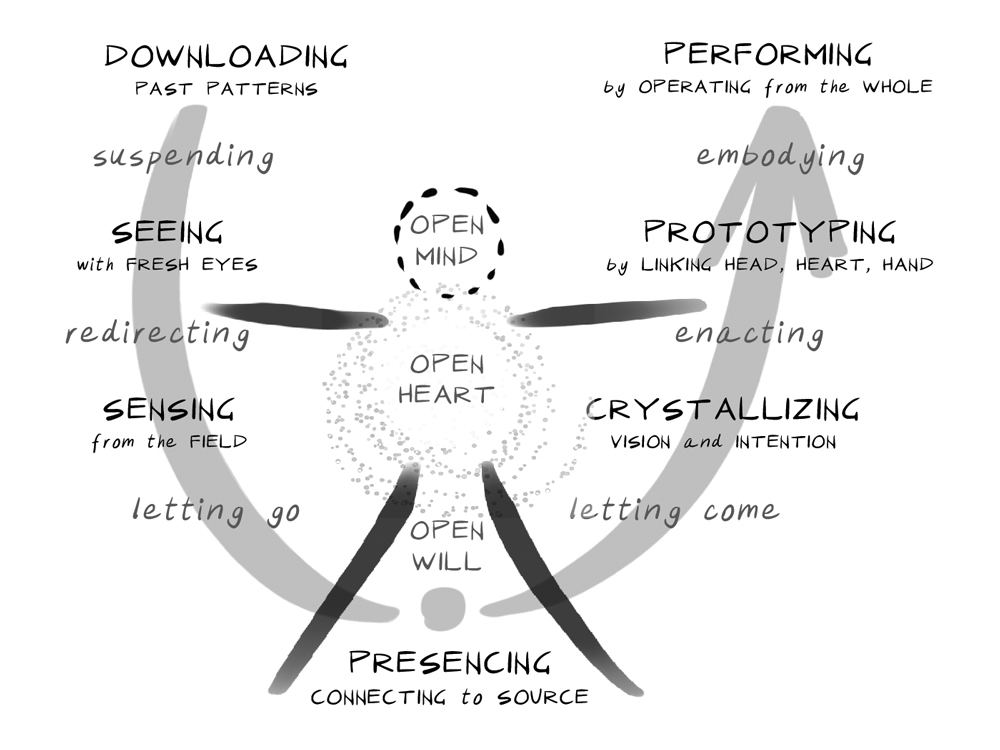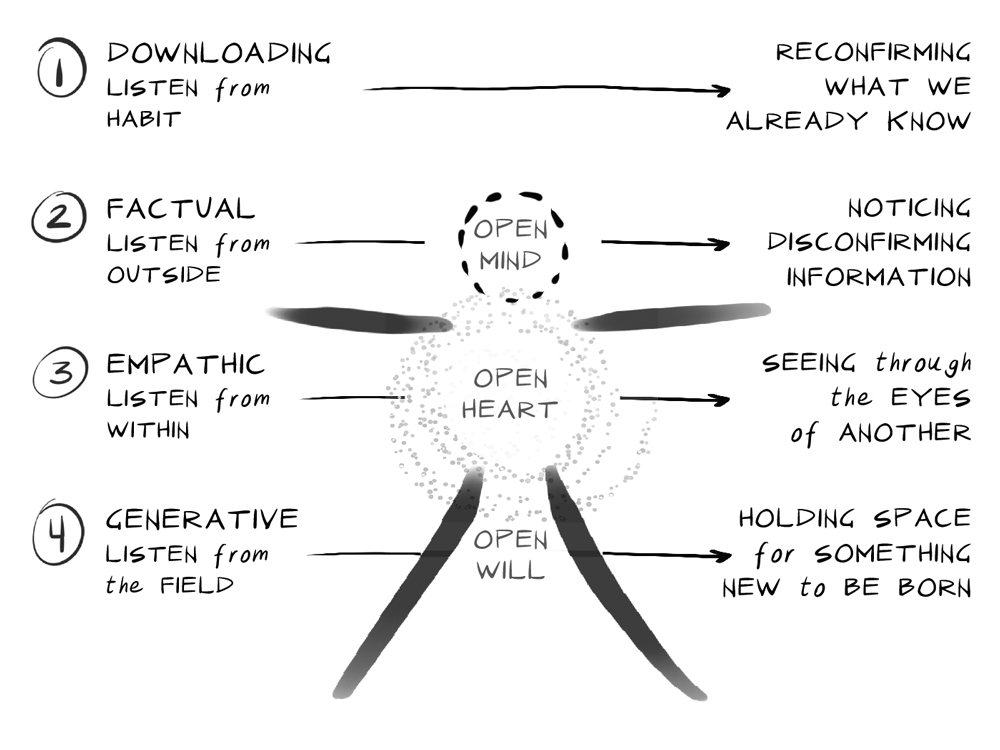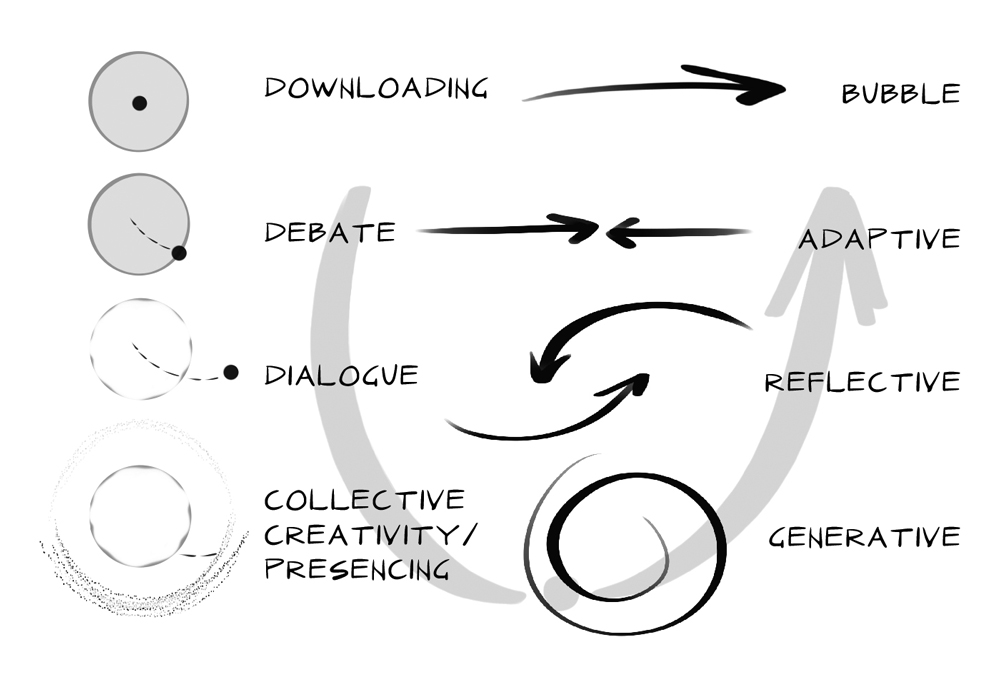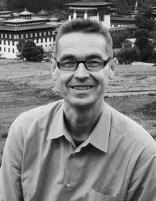
A Review
Reviewed in this article:
The Essentials of Theory U: Core Principles and Applications
Drawings by Kelvy Bird
Our models and strategies for activism are old and tired. They are primarily grounded in 19th century analyses and strategies that were, more or less, adequately updated throughout much of the 20th century until digital technology changed everything. If we see current realities through those lenses today, we are looking in rearview mirrors while a future is coming at us as we move into it.
We live in an age of massive disruption. So it makes sense to focus on how we can “learn from the future as it emerges,” which is one of the main themes of all Otto Scharmer’s work. The disruptions have us too off-balance, stressed, confused, ignorant of each other, righteous, separated, polarized, terrified, enraged, and more.

The Challenge of Disruption
Yes, we are without answers, but that does not need to leave us without finding new senses of direction and ways forward, especially ones not fueled so much by anger. There are more than a few coming forward, and Otto Scharmer of the Presencing Institute at the Massachusetts Institute of Technology is at that cutting-edge. I would go so far to say that he is the best strategic thinker for social change movements that I know of.
And, lucky us, he has just synthesized his life’s work on the frontiers of our time in a short, 170-page volume, The Essentials of Theory U: Core Principles and Applications. The book is dedicated to and written for “the emerging movement of people who bridge the three major divides of our time: the ecological, the social, and the spiritual divide.”
Overview
Theory U is the most comprehensive map for deep personal and social change that I know of, and many more people feel the same way. It offers:
a new understanding of leadership grounded in awareness and therefore inherently inclusive,
a framework and savvy narrative for approaching systemic change that makes personal and small collective change the source of our activism, and
a model of a platform for building a co-learning and action research networks to sense and work with emerging future possibilities.
It moves away from the lens of oppression and justice as the primary way of framing an approach to deep social change. Instead it presents an approach grounded in evolutionary and developmental dynamics which unites personal and social change in terms of both strategies and objectives.

Part I of the book gives the pragmatic framework of the approach to deep change; Part II, its methodology for consciousness-based systems change; and Part III, its overall narrative for evolutionary societal change.
Part II lays out how to develop and implement system-change projects in enough detail to take your breath away, but without getting dense. His focus is clear and sharp:
"I believe that the number-one leadership challenge in the world of business, government, and civil society is the same. It is to enable stakeholder groups that need each other to change the system to move from me to we—that is, from ego-system awareness to eco-system awareness."
That is, to move out of the self-centricity we are so stuck in toward an awareness of the whole that can inform both the strategy and implementation of change projects. This shift needs to happen at all levels: micro, meso, and macro.
Doing it involves the five movements of the Theory U process:
Co-initiating: uncovering shared intention—building a first container
Co-sensing: seeing reality from the edges of the system— establishing the horizontal connection
Co-presencing: connecting to your highest future potential— establishing the vertical connection
Co-creating: prototyping to learn by doing—bringing the new into reality
Co-shaping: embodying and institutionalizing the new— evolving the larger eco-system.
Scharmer then breaks each of these movements down into their outcomes, the principles at work, and specific practices.
Part III gives me problems, however. It plunges into the treacherous territory of taking social change to mass scale, and this has consistently led many change strategists into serious overreach. More on this later.
Leadership and Blindness
To be sure Theory U will not save us—if we can be saved—and it is not any kind of ultimate approach. But it is a powerful tool that can open us up to seeing how we can forge more transparent, cogent, loving, exciting, and competent movements. For example, consider how he treats leadership in Part I. First of all, it is not some mythic quality some great people possess. It is always a personal and collective dynamic because each one of us is always a personal and collective being. Secondly, it is primarily about awareness rather than being in-charge. Finally, Scharmer zeroes in on how it doesn’t work as the key to understanding how leadership works:
There is a blind spot in leadership, management, and social change. It is a blind spot that also applies to our everyday social experience. The blind spot concerns the inner place—the source—from which we operate when we act, communicate, perceive, or think. We can see what we do (results). We can see how we do it (process). But we usually are not aware of the who: the inner place or source from which we operate.
So this blind spot of leadership is deeply personal, right at the core of our being, at “the source level from which our attention and our actions originate.” It is also permanent. It comes with our DNA. We can only see reality through a pinhole, so we are constantly in deep need hearing how others are seeing.
Since we are always social—that is, always embedded in the dynamic of a multi-dimensional living culture—our blindness is also social. We see as we have learned to see, and much of what we see is through the lenses we share with each other. And in this we are like the proverbial fish in water who can’t tell they are in water. So sane leadership emerges from sensing and co-sensing what we don’t know.
But we are not fish. We have the capacity to sense that there is more going on within us and around us in the “social field” than we might be seeing. So, inner change is essential:
the essence of leadership is to become aware of our blind spot (these interior conditions or sources) and then to shift the inner place from which we operate as required by the situations we face.

He sees leadership as both a negative and positive thing. The negative side is coming to the problems and challenges without answers. From the positive it comes to “observe, observe, observe” until it has a sense of what might work. This begins an unending trial-and-error process of “iterate iterate iterate.”
Further, Scharmer says we need to see leadership as a collective capacity:
"The problem with leadership today is that most people think of it as being made up of individuals, with one person at the top. But if we see leadership as the capacity of a system to co-sense and co-shape the future, then we realize that all leadership is distributed—it needs to include everyone. To develop collective capacity, everyone must act as a steward for the larger ecosystem."
This is not a cry that everyone has the right to be heard. Through Scharmer’s eyes we can get a sense that our power can come more successfully from personal and collective commitments to hear each other in an effort to “co-sense” what is happening and emerging so that we can “co-create” a future that is sustainable and shareable.
More

Theory U is about much more than leadership and it is not hyped up theory. Rather, it fashions theory and organizational dynamics into a tool that coherently maps the social, economic, ecological, and spiritual struggles we are engaged with. It is about social evolution, social fields, levels of system, levels of consciousness, modes of listening, competition, governing, and more. And it is a tool that can be turned on itself to find and understand its own blind spots.
 I chose to focus on his treatment of leadership as one example of the freshness of his thinking, its radicalness in incorporating deep personal change at the core of any movement for deep social change, and how the Theory U map and framework always comes back to the pragmatics of creating what is needed. The book doesn’t do justice to the depth of TheoryU, but at less than 160 pages it does give a comprehensive taste of the approach. Further, it is an excellent companion for the free Massive Open Online Courses (MOOC) the Presencing Institute offers. In just a matter of a few years these courses have connected thousands of activists in small groups across the globe in the shared learning of Theory U and incorporating it into their collective efforts as they see fit in widely different domains and locales.
I chose to focus on his treatment of leadership as one example of the freshness of his thinking, its radicalness in incorporating deep personal change at the core of any movement for deep social change, and how the Theory U map and framework always comes back to the pragmatics of creating what is needed. The book doesn’t do justice to the depth of TheoryU, but at less than 160 pages it does give a comprehensive taste of the approach. Further, it is an excellent companion for the free Massive Open Online Courses (MOOC) the Presencing Institute offers. In just a matter of a few years these courses have connected thousands of activists in small groups across the globe in the shared learning of Theory U and incorporating it into their collective efforts as they see fit in widely different domains and locales.
Going to Scale
Part III is where I have a problem with Scharmer’s project, and where I think most people in our cooperative/solidarity economic movements will also. It is where he believes we can address the question, “how can we upgrade the economic, democratic, and educational operating systems in our societies” on a mass scale. This month, in fact, he and the Presencing Institute are collaborating with the Huffington Post in an online project they describe as taking “a deep dive into where and how the transformation of capitalism is already happening around the world.”
I don’t see how we can transform capitalism or any of the other systems at the maximum scale in our society. Two reasons. One, at this point in history we have neither the leverage nor the know-how to get the leverage needed to work at that scale. To think we do is, in my opinion, pipe dreaming. The second is stronger: the inherent design of capitalism drives it toward greater and greater inequality of wealth. It is my understanding that this is the whole thrust of Thomas Piketty’s rather definitive Capital in the 21stCentury. Martin O’Neill, an economist from the University of York, explains the radical implications of Pikettys work:
"Thomas Piketty’s Capital in the Twenty-First Century presents a troubling puzzle for social democrats and for parties of the centre-left, as well as for academics interested in developing a more egalitarian public policy agenda. Supported by a previously unimagined wealth of statistical detail, gained through the archival labour over many years of a large team of researchers, Piketty’s book confirms profound concerns about the long-range dynamics of capitalism. Wealth does not naturally disperse down to the many, but sticks to the few, and especially to those who carry the arbitrary advantages of patrimonial inheritance. The facts of inequality are devastating, and come with an accompanying sense of deflation at the level of policy and political action. We may have come to see the grim facts of capitalism’s internal dynamics more clearly than ever before, but it is much less clear that we have the tools to cure capitalism’s disfiguring disease of accelerating inequality. Hence we see that a common reaction to Piketty’s work on the left is one of resignation or even despair." (emphases added)
I do believe it is important to be thinking about and exploring what kind of holistic framework and strategy might generate large scale alternatives. This could even go far enough to infuse the current systems with more eco-system awareness, hopefully enough to spare us a planetary worst-case scenario, if that is still possible. But talking about the “transformation of capitalism” seems almost delusional. If this is the case, doing so runs the risk of sinking the ship the Presencing Institute and Huffington Post have just launched with its MOOC organizing and training platform.
However, I can’t leave my criticism at that. There are two reasons why. First, I was not at all prepared for the amazing experience I had in taking the Presencing Institute’s U Lab 1X course with hundreds of other activists this past fall and winter. It was the kind of movement platform and learning experience I might have vaguely imagined at a peak moment in my fantasy life. So maybe there are ways I am looking in the rearview mirror here. One of the major lessons of my life has been not to underestimate my blind spot. Therefore, I will be taking the free Transforming Capitalism Lab that begins this month to find out what I might be missing.
Second, and more basic, Scharmer may be seeing possibilities that aren’t so visible. An essential piece of the Theory U map and change process involves shifting “the quality of our attention from ego to eco from me to we.” This is no small matter. It is quite transformative. He argues that when this happens “the deeper conditions of the field open up, when the generative social field is being activated.” Elsewhere he gets more specific:
"I believe that the number-one leadership challenge in the world of business, government, and civil society is the same. It is to enable stakeholder groups that need each other to change the system to move from me to we—that is, from ego-system awareness to eco-system awareness." (emphasis added.)
This shift does not involve giving up self-interest for Scharmer. Rather it re-defines “self-interest” in terms of mutual benefit between individual and group. If this is the direction Scharmer is going with “transforming capitalism,” he might be seeing how society could re-direct "private enterprise" so they are driven by maximizing the common good rather than individual gain.
If so, it does seem a far reach, but why not give him the room to make his case.
Go to the GEO front page
Citations
Michael Johnson (2018). The Essentials of Theory U: A Review. Grassroots Economic Organizing (GEO). https://geo.coop/story/essentials-theory-u

Add new comment